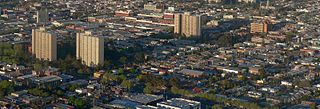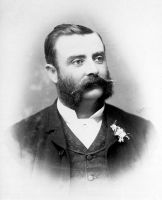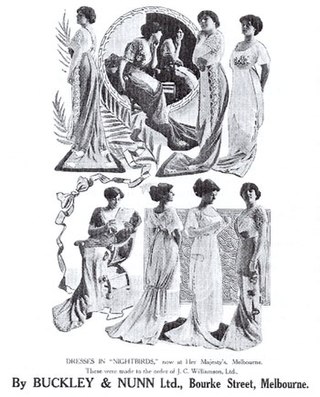
Collingwood is an inner-city suburb in Melbourne, Victoria, Australia, 3km north-east of the Melbourne central business district, located within the City of Yarra local government area. Collingwood recorded a population of 9,179 at the 2021 census.

William Pitt was an Australian architect and politician. Pitt is best known as one of the outstanding architects of the "boom" era of the 1880s in Melbourne, designing some of the city's most elaborate High Victorian commercial buildings. He worked in a range of styles including Gothic Revival, Italianate, French Second Empire, and his own inventive eclectic compositions. He had a notable second career after the crash of the 1890s, becoming a specialist in theatres and industrial buildings.

Rundle Mall is a pedestrian street mall located in Adelaide, South Australia. It was opened as a pedestrian mall in September 1976 by closing the section of Rundle Street between King William Street and Pulteney Street, to vehicular traffic. The street continues as Rundle Street to the east and Hindley Street to the west.

The Downing Centre is a major heritage-listed former department store and now courthouse complex in Sydney, New South Wales, Australia. It features state government courts, including the Local Court, the District Court, and a law library known as the Downing Centre Library. The Downing Centre forms part of the Department of Communities and Justice and houses court services and sheriffs offices.

Rundle Street, often referred to as "Rundle Street East" as distinct from Rundle Mall, is a street in the East End of the city centre of Adelaide, the capital of South Australia. It runs from Pulteney Street to East Terrace, where it becomes Rundle Road through the East Park Lands. The street is close to Adelaide Botanic Gardens, Rundle Park, Rymill Park, Hindmarsh Square and North Terrace.

Lonsdale Street is a main street and thoroughfare in the Melbourne central business district, Australia. It runs roughly east–west and was laid out in 1837 as one of Melbourne's original boundaries within the Hoddle Grid. The street extends from Spring Street in the east to Spencer Street in the west.

Anthony Hordern & Sons was a major department store in Sydney, New South Wales, Australia. With 52 acres of retail space, Anthony Hordern's was once the largest department store in the world. The historic Anthony Hordern building, which was located on a block bounded by George Street, Liverpool, Pitt and Goulburn Streets, on what was a small hill called Brickfield Hill in the Sydney central business district, was controversially demolished in 1986, to make way for the World Square development.

A coffee palace was an often large and elaborate residential hotel that did not serve alcohol, most of which were built in Australia in the late 19th century.

John Martin & Co. Ltd, colloquially known as John Martin's or simply Johnnies, was an Adelaide-based company which ran a popular chain of department stores in South Australia. It operated for more than 130 years, from 1866 until its closure in 1998. Johnnies, owned by the prominent Hayward family for the majority of its existence, became an Adelaide icon, responsible for the famous Adelaide Christmas Pageant. It was latterly owned by David Jones.

Pulteney Street is a main road which runs north-south through the middle of the eastern half of the Adelaide city centre, in Adelaide, South Australia. It runs north-south from North Terrace, through Hindmarsh and Hurtle Squares, to South Terrace, where it becomes Unley Road. It is the only one of the city centre's major north-south thoroughfares that does not continue northwards over North Terrace.

Buckley & Nunn was a department store in Melbourne, Victoria, Australia. It first opened its doors in 1851 as a drapery store and, in its heyday, competed creditably as a department store with Myer (1900). It occupied a succession of buildings on Bourke Street in Melbourne's City Centre until it was taken over by David Jones in 1982.
Charles Moore and Co. was a company based in Adelaide, South Australia which owned a number of department stores in three Australian states. It was founded by Irish-born businessman, Charles Moore. Its best-known assets were the department store known to two generations of Adelaideans as "Moore's on the Square", Charles Moore's on Hay Street, Perth, Western Australia and Read's in Prahran, Victoria.
Malcolm Donald Reid was a South Australian timber merchant and businessman, founder of several furniture stores that bore his name.
J. T. Fitch & Son was an Adelaide drapery store established by John Thomas Fitch, and carried on by his son John Thomas Fitch, jr.

Emporium Melbourne is a luxury shopping centre on the corner of Lonsdale and Swanston streets in Melbourne, Australia. Occupying the former Lonsdale Street site of Myer's Melbourne store, Emporium opened in 2014 following extensive redevelopment. The centre includes a food court, specialty stores and several multi-level anchor retailers. Emporium forms part of a 188,000 square metres (2,020,000 sq ft) precinct of linked shopping centres in the Melbourne central business district, which also includes the Myer and David Jones city stores, Melbourne Central, General Post Office and Elizabeth Street's The Strand.

Charles Atkins Hornabrook was a businessman in the colony of South Australia who made a fortune from property development in the city of Adelaide and investments in Broken Hill Proprietary and other mining prospects. He is remembered as the owner and developer of the York Hotel, at the time regarded as Adelaide's finest.
James Marshall & Co. was a department store in Adelaide, South Australia, which was taken over by Myer in 1928.
George Frederick Claridge was a South Australian businessman and philanthropist, longtime chairman of the Home for Incurables.
HW & FB Tompkins was an architectural firm established by the brothers Henry (Harry) William and Frank Beauchamp Tompkins in 1898 in Melbourne, Australia. They went on to become a major commercial firm, designing a large number of department stores, hotels, clubs and office buildings and banks over the next 40 years, many in central Melbourne and most still standing. They were stylistic and structural innovators, an area best known for the huge Myer Department store in Bourke Street, built in many stages in different styles from 1914 to 1933.
Alfred George Chapman, invariably referred to as A. G. Chapman, was a builder in the early days of Adelaide, South Australia.















